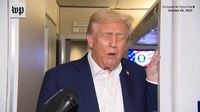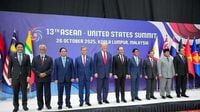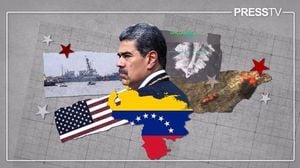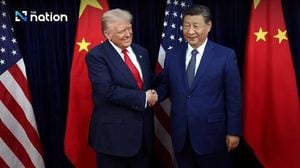President Donald Trump has once again thrust U.S.-Canada trade relations into the spotlight, announcing plans to impose an additional 10% tariff on Canadian imports. The move, revealed on October 25, 2025, comes as a direct response to an anti-tariff television ad aired by the province of Ontario during the first two games of the World Series. The ad, which featured the words of former President Ronald Reagan criticizing tariffs, was seen by Trump as a hostile act and a misrepresentation of facts, prompting his decision to escalate the already tense trade dispute between the two neighboring countries, according to the Associated Press.
The advertisement, which ran on October 25 and 26, sparked immediate backlash from Trump, who took to his Truth Social platform while aboard Air Force One en route to Malaysia. In his post, the president did not mince words: “Their Advertisement was to be taken down, IMMEDIATELY, but they let it run last night during the World Series, knowing that it was a FRAUD.” He continued, “Because of their serious misrepresentation of the facts, and hostile act, I am increasing the Tariff on Canada by 10% over and above what they are paying now.”
Ontario Premier Doug Ford responded by stating he would pull the ad after the weekend, but the damage was already done in Trump’s eyes. The ad, which used a 1987 address by Reagan—long revered in Republican circles—was perceived by the White House as a calculated attempt to influence U.S. policy and even sway the Supreme Court ahead of arguments next month about Trump’s tariff authority. Trump has complained that the ad was aimed at influencing the U.S. Supreme Court ahead of arguments scheduled for next month that could decide whether he has the power to impose his sweeping tariffs, a key part of his economic strategy. Lower courts had ruled he had exceeded his authority, as reported by the Associated Press.
The legal authority for this new round of tariffs remains unclear. The White House has not specified when the 10% hike will take effect or whether it will apply to all Canadian goods. The ambiguity has left Canadian officials scrambling for answers. Dominic LeBlanc, Canada’s minister responsible for U.S. trade issues, sought to defuse the situation by emphasizing that trade negotiations are a matter for the federal government, not provincial leaders. “Progress is best achieved through direct engagement with the U.S. administration,” LeBlanc said in a statement, as cited by the Associated Press.
Canada’s economy, already battered by existing tariffs, faces mounting challenges. Many Canadian products are subject to a 35% tariff, while steel and aluminum have been hit with rates as high as 50%. Energy products have fared slightly better, facing a 10% tariff. However, the vast majority of goods are covered by the U.S.-Canada-Mexico Agreement (USCMA), which exempts them from tariffs—though that agreement is currently under review. Trump, who negotiated the deal during his first term, has since soured on its terms, raising further uncertainty about the future of North American trade.
Canadian Prime Minister Mark Carney, who has been working to lower tariffs alongside his U.S. counterpart, now faces a daunting task. More than three-quarters of Canadian exports are destined for the United States, with nearly $3.6 billion Canadian ($2.7 billion U.S.) worth of goods and services crossing the border each day. The economic stakes could hardly be higher, especially as Canada’s export-driven economy continues to absorb the shock of rising trade barriers.
Despite both leaders attending the Association of Southeast Asian Nations (ASEAN) summit in Malaysia, Trump made it clear he had no intention of meeting Carney. “I have no intention of meeting with Prime Minister Carney,” Trump told reporters traveling with him, according to the Associated Press and Washington Bureau. The snub underscores the personal and political tensions that have come to define the bilateral relationship in recent years.
While the U.S.-Canada spat dominated headlines, Trump’s Asia trip was marked by a flurry of other diplomatic activity. The president met with Brazilian President Luiz Inácio Lula da Silva, who urged the U.S. to lower steep tariffs imposed earlier in the year. Trump also attended a signing ceremony for an expanded ceasefire between Cambodia and Thailand, using the threat of tariffs as leverage to push both countries toward peace. “Alongside this peace treaty, we are also signing a major trade deal with Cambodia and a very important critical minerals agreement with Thailand,” Trump announced at the ceremony. “The United States will have robust commerce and cooperation, transactions, lots of them, with both nations as long as they live in peace.”
Trade tensions with China also loomed large over the summit. Trump expressed optimism about reaching a “comprehensive deal” with Beijing, despite having previously threatened to impose an additional 100% tariff on Chinese imports starting November 1 in response to new restrictions from Beijing on rare earth minerals. “I think we have a really good chance of making a very comprehensive deal,” Trump told reporters over the weekend, as reported by the Washington Bureau. China’s top trade negotiator echoed that sentiment, saying both sides had achieved “preliminary consensus” on some areas of dispute.
The White House’s aggressive use of tariffs as a tool of economic and diplomatic pressure has drawn mixed reactions at home and abroad. Supporters argue that Trump’s tough stance is necessary to protect American industries and jobs, while critics warn of rising costs for consumers and the risk of sparking broader trade wars. The latest escalation with Canada—America’s largest trading partner—has only heightened those concerns, especially given the interconnected nature of the two economies.
For now, the fate of the 10% tariff hike remains uncertain. With the U.S. Supreme Court set to weigh in on the president’s authority to impose such measures, and with the USCMA under review, both countries face a period of heightened uncertainty. As Trump continues his whirlwind diplomatic tour of Asia, the world will be watching to see whether his hardball tactics yield results or simply deepen existing divides.
One thing is clear: the stakes for North American trade and global economic stability have rarely been higher. As the dust settles from this latest round of brinkmanship, businesses, workers, and consumers on both sides of the border are left to wonder what comes next.





